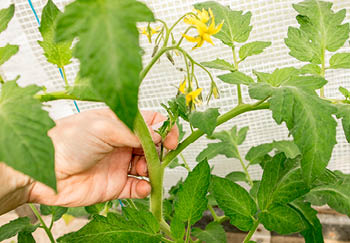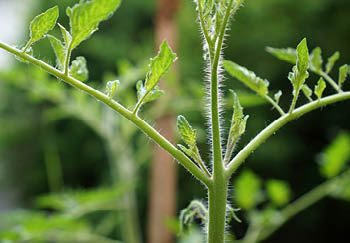Pinching out your tomatoes is an essential part of tomato plant care. That’s because tomato plants naturally grow bushy, and if you let them grow the way they want, they’ll focus on growing leaves instead of fruit. Naturally, no one wants that; the goal is to grow lots of beautiful tomatoes. By pinching out the stems and leaves on a regular basis, you will make sure that the plant’s energy goes into growing the fruit and not the leaves. You should make sure you only remove the right parts, though, and not anything that will stop or even hurt the plant from making fruit.
When plants are growing, it’s not always clear which parts to pinch out and which to leave alone. This helpful guide will point you in the right direction. You can find links to two other guides at the end of this page if you want to learn how to grow tomatoes at home but are not yet ready to pinch out. Ready to start pinching out your tomato plants? Let’s go!.
As a tomato gardener, you’ve likely heard conflicting advice about pinching out the suckers on tomato plants. Is this pruning step essential or totally unnecessary? Will pinching boost yields or reduce them? Let’s dive into the great tomato pinching debate and discuss the pros and cons of this classic gardening practice.
What is Pinching Tomatoes?
Pinching tomatoes refers to removing the suckers – those small side shoots that emerge where the leaf stems meet the main vine. It’s done by simply snapping or pinching off these new branches while they are still small and tender.
The goal is to direct the plant’s energy into the main stem and fruit production rather than excessive foliage and suckers, It helps keep plants tidy and prevents a tangled mess of out-of-control vines
Reasons to Pinch Out Tomato Suckers
Here are some of the proposed benefits of diligently pinching your tomatoes:
-
Prevents plants from becoming overgrown and unruly
-
Allows more airflow and light penetration to lower leaves and fruit
-
Removes potential entry points for disease and pests
-
Conserves moisture by reducing foliage
-
Encourages larger, tastier fruit production
-
Makes staking and pruning easier
-
Easier to inspect and harvest ripe tomatoes
For all these reasons, pinching tomatoes has long been standard gardening advice. So what’s the opposing view?
Reasons Not to Pinch Tomato Suckers
Here are some reasons why pinching might not be beneficial:
-
Causes stress to plants and delays fruit ripening
-
Removes leaves that produce energy via photosynthesis
-
Reduces overall yield per plant
-
Extra stems act as backups if disease strikes main stem
-
More stems mean more places for fruit to set
-
Total crop weight is often higher on unpruned plants
-
Extra foliage protects fruit from sunscald
-
Allows tomato varieties’ natural growth habits to flourish
The Pinching Verdict
After looking at the pros and cons, the choice comes down to your gardening priorities. Here are the key takeaways:
-
Pinching produces slightly fewer but larger sized tomatoes per plant.
-
Not pinching often results in higher total yields but smaller tomatoes.
-
Plants allowed to grow naturally take up more space and require staking.
-
Pruning is ideal for gardening competitions and record-breaking tomatoes!
-
Pinching is more work but gives greater control over plant shape.
-
Unpinched plants are better for small spaces and high density gardening.
Ultimately, it’s up to your personal preferences and goals. You really can’t go wrong either way. I suggest trying both pinched and unpinched tomatoes to discover what works best for your gardening style and needs.
Here are some tips to incorporate into your tomato care routine whether you pinch or not:
Tips for Pinching Tomatoes
If you decide to pinch out your tomatoes, follow these tips:
-
Use clean, sanitized shears or garden scissors to prevent disease transmission.
-
Start when plants are 1-2 feet tall and pinch every 1-2 weeks thereafter.
-
Just pinch back to the first set of leaves – no need to decapitate the sucker entirely!
-
Try leaving 2 suckers on hardy plants and 1 sucker on those prone to disease.
-
Allow all suckers to grow on container tomatoes to increase yields.
-
Pinch carefully to avoid damaging the main stem.
-
Be diligent as it’s easy to miss suckers; don’t let them get too big.
Tips If Not Pinching Tomatoes
If you opt not to pinch, keep these tips in mind:
-
Use sturdy cages, stakes, or trellises to support unruly growth.
-
Space plants wider apart to allow adequate airflow and light as they fill out.
-
Prune selectively rather than letting plants go completely wild.
-
Remove lower leaves shading fruits but keep higher leaves for energy production.
-
Check for pests and disease regularly in the dense foliage.
-
Train excess stems back into the cages or trellises.
-
Harvest frequently as the plethora of smaller tomatoes ripens.
Make an Informed Decision
I hope examining both perspectives on the great tomato pinching debate has helped you decide whether or not it’s the right choice for your garden. The most important thing is making an intentional, informed decision rather than blindly following whichever tradition you heard first. And no matter which approach you take, prospering tomato plants and a bountiful harvest are within your reach!
What are Tomato Trusses?
A tomato truss is the stem that carries the flowers, which then turn into lovely tomatoes. To spot a truss, look for a group of shorter stems where flower heads or yellow flowers are growing. Tomato trusses always grow from a stem and never where the leaf joins the stem.

How Often Should I Pinch Out?
Check your tomato plants once a week and remove any side shoots as they appear. The sooner the better to divert all the energy of the plant into growing fruit rather than foliage.

You’re Pruning Tomatoes WRONG! This Mistake Will DESTROY Your Harvest!
FAQ
Do tomatoes need to be pinched back?
When should I start pinching out side shoots on tomatoes?
What happens if you don’t cage tomatoes?
What happens if you don’t pinch out a tomato plant?
If you don’t pinch out the side shoots, these will flower and pull the energy away from the main shoots. This will ultimately produce fewer tomatoes and lower quality tomatoes. You should pinch out your tomato plant and train the single-stemmed plant, by tying it in with a tall cane.
Do Tomatoes need to be pinched out?
Bush or determinate tomatoes benefit from pinching out as it encourages extra branches, which produce fruit at their tips. Cordon or indeterminate tomatoes don’t need pinching out but can develop two shorter main stems, rather than one tall one, leading to easier management. Note: Pinching out can also refer to pinching out side shoots and suckers.
Do you pinch out side shoots on Tomatoes?
Pinching out is all about removing the side shoots. Pinching out Tomatoes is all about removing the side shoots or “suckers” as your plant grows. These shoots appear on the main stem above the leaves. This is something that is only done on vining tomatoes, if you are growing bush tomatoes, then you don’t need to pinch out side shoots.
What does pinching out Tomatoes mean?
Pinching out is an easy process of removing extra side shoots with your fingers, so the plant puts its energy into growing one single stem with fewer branches and larger fruits. You can also pinch out the top of the main stem (or growing tip) to stop the tomato plant growing too tall.
- The Ultimate Guide to Growing Strawberries in Raised Beds - August 8, 2025
- No-Dig Garden Beds: The Easiest Way to Grow a Beautiful Garden - August 6, 2025
- How to Protect and Preserve Wood for Raised Garden Beds - August 6, 2025

